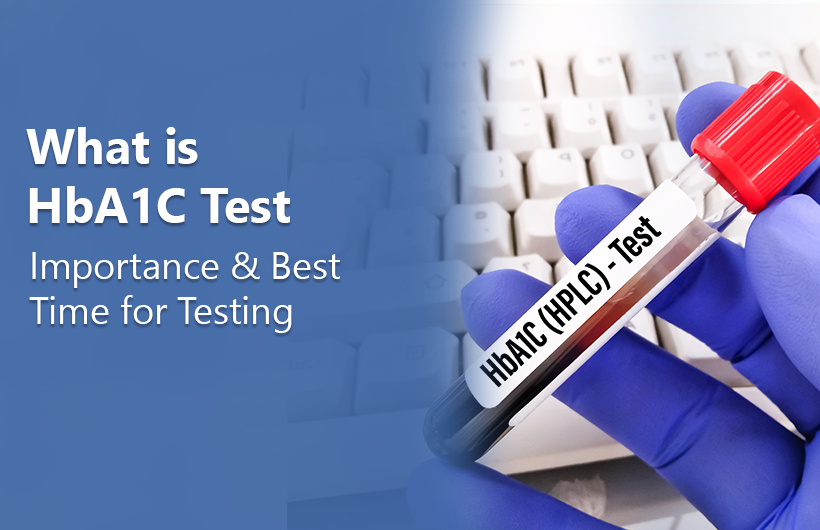Managing diabetes effectively requires more than just daily sugar checks. One of the most essential tools for long-term monitoring is the Hemoglobin A1C test. It helps both patients and doctors understand how well blood sugar levels have been controlled over time. In this blog, Dr. Moxit Shah explains what the HbA1C test means, its importance, normal levels, and the best time for testing to ensure optimal diabetes management.
What is the Hemoglobin A1C Test?
The Hemoglobin A1C test, also called the glycated hemoglobin test or HbA1C blood test, is a simple yet powerful way to measure the average blood sugar (glucose) levels over the past two to three months. Unlike daily blood sugar tests, which show immediate results, the HbA1C test reflects long-term control and gives a bigger picture of how well diabetes is being managed.
Hemoglobin is a protein found in red blood cells that carries oxygen throughout the body. When sugar enters the bloodstream, it attaches to hemoglobin, forming glycated hemoglobin (HbA1C). The higher your blood sugar, the more glycated hemoglobin is formed. The HbA1C test measures this percentage, helping diabetes specialists in Ahmedabad, like Dr. Moxit Shah assess how effectively your blood sugar levels have been controlled.
How Does It Differ from Daily Sugar Checks?
Daily sugar checks or finger-prick glucose tests measure your blood sugar at a specific moment before meals, after meals, or at bedtime. These readings are useful for short-term management, such as adjusting insulin or medication doses.
However, the HbA1C test for diabetes provides an average over 8–12 weeks, showing whether your daily efforts are paying off in the long run. It helps identify trends that daily readings might miss, such as consistently high sugars after meals or poor nighttime control. Together, both tests give a complete view of diabetes management.
Why is the HbA1C Test Important for Diabetes Management?
The Hemoglobin A1C test is one of the most valuable tools for both diagnosing and monitoring diabetes. It helps in several ways:
- Early Diagnosis: A single HbA1C test can help diagnose prediabetes or diabetes without the need for fasting.
- Monitoring Progress: For people already living with diabetes, it shows how effectively blood sugar has been managed over time.
- Treatment Adjustment: Based on HbA1C results, doctors can modify treatment plans, medications, or lifestyle recommendations.
- Preventing Complications: Keeping HbA1C within the target range helps reduce the risk of diabetes-related complications like nerve damage, kidney disease, and vision problems.
According to Endocrinologist in Ahmedabad Dr. Moxit Shah, understanding your HbA1C results empowers you to take better control of your diabetes and make informed decisions about your health.
Normal HbA1C Levels and What They Mean
Knowing your HbA1C number is key to understanding your diabetes status. Here’s a general guide:
- Normal: Below 5.7%
- Prediabetes: 5.7% – 6.4%
- Diabetes: 6.5% or higher
For most people with diabetes, the goal is to keep HbA1C below 7%. However, this target may vary based on age, overall health, and other medical conditions. Your doctor will recommend a personalised goal based on your situation.
Maintaining a healthy HbA1C level means your blood sugar is under good control, reducing the chances of long-term complications.
When Is the Best Time for an HbA1C Test?
Many patients often wonder: “When should I get an HbA1C test done?”
The best time for an HbA1C test depends on your diabetes status and treatment plan.
- For Newly Diagnosed Patients: The test is usually recommended every 3 months to monitor how well treatment works.
- For Well-Controlled Diabetes: If your blood sugar has been stable, your doctor may suggest testing every 6 months.
- After Treatment Changes: When medications or insulin doses are adjusted, a repeat test in 3 months helps assess improvement.
Unlike fasting blood sugar tests, the HbA1C test can be done at any time of the day—you don’t need to fast or follow special dietary rules. It gives consistent results regardless of when you last ate, making it convenient and reliable.
How Often Should You Get an HbA1C Test Done?
The HbA1C monitoring frequency is typically every 3 to 6 months, depending on your doctor’s advice. People struggling to meet their target HbA1C or those with frequent sugar fluctuations may need more frequent testing.
Regular testing ensures your diabetes management plan is working effectively and helps your doctor make necessary adjustments before complications arise.
How the HbA1C Test is Done
The HbA1C blood test is a simple procedure done at a diagnostic lab or clinic. A small blood sample is drawn from a vein in your arm. The process takes only a few minutes, and no fasting is required.
The results are usually available within a day and show your HbA1C as a percentage. Higher percentages indicate poorer blood sugar control. Since the test is easy, quick, and doesn’t require preparation, it’s an excellent choice for regular monitoring.
Limitations of the HbA1C Test
While the HbA1C test is reliable for most people, there are situations where results may not be entirely accurate. These include:
- Anaemia or Blood Disorders: Conditions affecting red blood cells can alter HbA1C readings.
- Pregnancy: Rapid changes in blood sugar and red cell turnover may affect accuracy.
- Kidney or Liver Disease: These can interfere with hemoglobin and distort results.
- Recent Blood Loss or Transfusion: They can lower or falsely change HbA1C levels.
In such cases, doctors may recommend alternative tests, such as fructosamine testing, which reflects short-term glucose control.
HbA1C Test vs Daily Blood Sugar Testing — Which Is More Important?
Many patients ask, “If I check my blood sugar every day, do I still need an HbA1C test?” The answer is yes.
Both tests serve different but complementary purposes:
- Daily blood sugar testing shows immediate results and helps with short-term management, adjusting insulin, diet, or exercise.
- The HbA1C test shows long-term patterns and overall control.
Using both allows for better diabetes care. Daily reading helps manage immediate needs, while HbA1C ensures long-term success and helps detect hidden patterns.
How to Improve Your HbA1C Levels
Improving HbA1C levels involves consistent efforts in maintaining healthy blood sugar levels. Some effective strategies include:
- Following a balanced diet rich in fibre and low in refined sugars.
- Engaging in regular physical activity.
- Taking prescribed medications on time.
- Managing stress and getting enough sleep.
- Monitoring blood sugar regularly and noting any trends.
Consulting an expert like Dr. Moxit Shah can help you develop a personalised diabetes control plan that suits your lifestyle and health goals.
Conclusion
The Hemoglobin A1C test is more than just a number, it’s a reflection of how well you’re managing your diabetes over time. By getting tested regularly and understanding your results, you can take control of your health and prevent complications.
Remember, the best time for the HbA1C test depends on your condition, but most patients should undergo it every 3–6 months. Discuss with your doctor about your ideal frequency and target range.
With guidance from diabetes experts like Dr. Moxit Shah, staying on top of your HbA1C levels becomes simpler, helping you live a healthier and more balanced life with better diabetes control.






